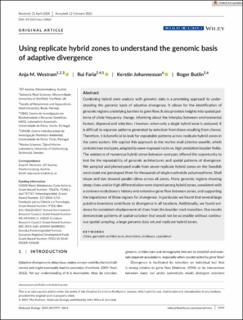| dc.contributor.author | Westram, Anja Marie | |
| dc.contributor.author | Faria, Rui | |
| dc.contributor.author | Johannesson, Kerstin | |
| dc.contributor.author | Butlin, Roger K. | |
| dc.date.accessioned | 2022-07-11T09:49:29Z | |
| dc.date.available | 2022-07-11T09:49:29Z | |
| dc.date.created | 2021-12-07T09:57:04Z | |
| dc.date.issued | 2021 | |
| dc.identifier.citation | Westram, A. M., Faria, R., Johannesson, K. & Butlin, R. (2021). Using replicate hybrid zones to understand the genomic basis of adaptive divergence. Molecular Ecology, 30(15), 3797-3814. doi: | en_US |
| dc.identifier.issn | 1365-294X | |
| dc.identifier.uri | https://hdl.handle.net/11250/3004510 | |
| dc.description.abstract | Combining hybrid zone analysis with genomic data is a promising approach to understanding the genomic basis of adaptive divergence. It allows for the identification of genomic regions underlying barriers to gene flow. It also provides insights into spatial patterns of allele frequency change, informing about the interplay between environmental factors, dispersal and selection. However, when only a single hybrid zone is analysed, it is difficult to separate patterns generated by selection from those resulting from chance. Therefore, it is beneficial to look for repeatable patterns across replicate hybrid zones in the same system. We applied this approach to the marine snail Littorina saxatilis, which contains two ecotypes, adapted to wave-exposed rocks vs. high-predation boulder fields. The existence of numerous hybrid zones between ecotypes offered the opportunity to test for the repeatability of genomic architectures and spatial patterns of divergence. We sampled and phenotyped snails from seven replicate hybrid zones on the Swedish west coast and genotyped them for thousands of single nucleotide polymorphisms. Shell shape and size showed parallel clines across all zones. Many genomic regions showing steep clines and/or high differentiation were shared among hybrid zones, consistent with a common evolutionary history and extensive gene flow between zones, and supporting the importance of these regions for divergence. In particular, we found that several large putative inversions contribute to divergence in all locations. Additionally, we found evidence for consistent displacement of clines from the boulder–rock transition. Our results demonstrate patterns of spatial variation that would not be accessible without continuous spatial sampling, a large genomic data set and replicate hybrid zones. | en_US |
| dc.language.iso | eng | en_US |
| dc.publisher | Wiley | en_US |
| dc.rights | Navngivelse 4.0 Internasjonal | * |
| dc.rights.uri | http://creativecommons.org/licenses/by/4.0/deed.no | * |
| dc.title | Using replicate hybrid zones to understand the genomic basis of adaptive divergence | en_US |
| dc.title.alternative | Using replicate hybrid zones to understand the genomic basis of adaptive divergence | en_US |
| dc.type | Peer reviewed | en_US |
| dc.type | Journal article | en_US |
| dc.description.version | publishedVersion | en_US |
| dc.rights.holder | © 2021 The Authors | en_US |
| dc.subject.nsi | VDP::Matematikk og Naturvitenskap: 400::Basale biofag: 470::Genetikk og genomikk: 474 | en_US |
| dc.subject.nsi | VDP::Matematikk og Naturvitenskap: 400::Basale biofag: 470::Molekylærbiologi: 473 | en_US |
| dc.subject.nsi | VDP::Matematikk og Naturvitenskap: 400::Basale biofag: 470::Biofysikk: 477 | en_US |
| dc.source.pagenumber | 3797-3814 | en_US |
| dc.source.volume | 30 | en_US |
| dc.source.journal | Molecular Ecology | en_US |
| dc.source.issue | 15 | en_US |
| dc.identifier.doi | 10.1111/mec.15861 | |
| dc.identifier.cristin | 1965407 | |
| dc.relation.project | EC/H2020/706376 | en_US |
| dc.relation.project | EC/H2020/754411 | en_US |
| dc.relation.project | EC/H2020/797747 | en_US |
| dc.relation.project | Vetenskapsrådet: 217-2008-1719 | en_US |
| dc.relation.project | Natural Environment Research Council: K014021/1 | en_US |
| dc.relation.project | EC/H2020/693030 | en_US |
| dc.relation.project | European Regional Development Fund: POCI-01-0145- FEDER-030628 | en_US |
| dc.relation.project | Fundação para a Ciência e a Tecnologia: PTDC/BIA-EVL/30628/2017 | en_US |

